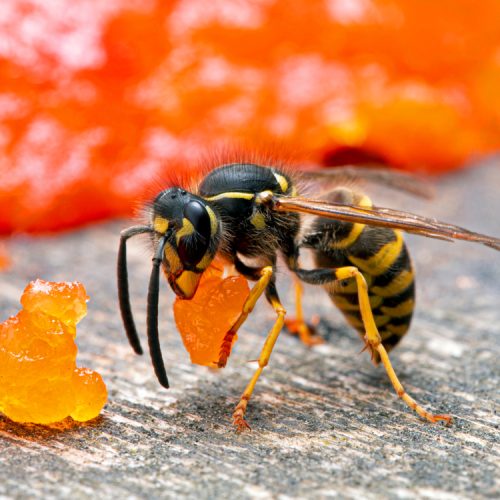For many Missouri homeowners, the sight of buzzing black and yellow striped insects around their yards is an all-too-familiar concern. Identifying whether you’re dealing with hornets or yellow jackets is key to protecting your family and your property. While both are wasps, they differ significantly in appearance, nesting, behavior, and threats.
This guide will walk through the key differences between hornets and yellow jackets so Missouri residents can make informed decisions when managing infestations, ensuring safety for all.
Physical Differences: How to Identify Hornets and Yellow Jackets
Size and Coloration
The first step in identifying these stinging insects is appearance.
- Yellow Jackets are smaller, typically reaching about ½ inch in length. They have bright yellow and black patterns, a distinct narrow “wasp waist,” and smooth, shiny bodies.
- Hornets, particularly the bald-faced hornet common in Missouri, are larger, measuring ⅝ to 1 inch in length. Their most notable feature is a black body with white or ivory markings. They appear fuller-bodied with rounded heads and thicker waists compared to the sleek build of yellow jackets.
Flight Patterns
Their flight patterns are another clue.
- Yellow jackets dart quickly in all directions, often hovering near food sources like picnic tables, trash cans, and open drinks.
- Hornets have more deliberate and controlled flight patterns, often found in higher locations like trees, eaves, and roofs, rather than ground-level food sources.
By observing size, coloration, and flight habits, you can determine whether you’re facing yellow jackets or hornets.
Nesting Habits: How Hornets and Yellow Jackets Build Homes
Location is everything when it comes to nests. Hornets and yellow jackets differ significantly in both the placement and construction of their nests.
Yellow Jacket Nests
Yellow jackets are versatile in their nesting choices.
Underground Nests
Yellow jackets often reuse abandoned rodent burrows, creating concealed nests underground. Their entrance holes, usually 1-2 inches wide, can pop up around foundations, under landscaping, or lawn areas. These nests can grow to colonies of up to 15,000 insects by late summer. Disturbing one during lawn care can lead to aggressive swarms.
Structural Nests
These nests are hidden within walls, attics, and voids in structures. Entry points might be small openings in siding or utility penetrations. They can even chew through drywall to enter living spaces. Hidden nests like these make them challenging to locate and remove.
Yellow jacket nests consist of paper-like material made from chewed wood fibers, and they’re typically not visible unless damaged or opened.
Hornet Nests
Hornet nests are the easiest of the two to spot.
- Hornets create aerial nests that are suspended in trees, under eaves, or on structures. These teardrop-shaped nests are fully enclosed with a single entrance at the bottom. By late summer, they can grow to sizes as large as basketballs.
- Unlike yellow jacket nests, hornet nests are visible early on, giving homeowners a chance to address the problem before colonies grow large. Their off-ground location also reduces the chance of unwelcome encounters during regular yard activities.
Spotting and addressing nests early can reduce the risk of stings and property damage.
Assessing Risk and Aggression Levels
Understanding the behavior of yellow jackets and hornets helps to assess the potential danger they pose.
Aggression Levels
- Yellow Jackets are more aggressive and persistent. If threatened, they chase perceived threats for over 50 feet and can sting multiple times. Their aggression peaks toward late summer and fall when food supplies diminish. They’re also nuisances at outdoor gatherings where human food attracts them.
- Hornets are less aggressive when away from their nests but fiercely territorial near them. They’re less likely to disturb picnic tables or garbage cans compared to yellow jackets. However, their stings are more painful due to their size and venom potency.
Feeding Habits
Both insects are beneficial predators in small numbers.
- Yellow jackets predominantly scavenge for sugary drinks, human food, and protein, making them frequent visitors to outdoor barbecues.
- Hornets primarily feed on other insects, helping control pest populations. They rarely scavenge human food.
Understanding these behaviors can help you safely coexist with these wasps while minimizing risks.
Safety Concerns: Stings and Prevention
Both hornet and yellow jacket stings are painful, but they can also pose serious health risks for those allergic to wasp venom. Here’s how you can stay safe.
Managing Infestations
Identifying and addressing nests as soon as they are noticed is key. However, when nests grow larger or become difficult to access, professional help is strongly recommended to avoid dangerous stings.
First Aid for Stings
If stung by a yellow jacket or hornet, follow these steps immediately:
- Clean the sting area with soap and water.
- Apply a cold pack to reduce swelling.
- Take antihistamines to manage itching or swelling.
- Seek medical attention for severe reactions or multiple stings.
Being prepared can significantly reduce the risk of further harm.
Why Choose Professional Pest Control
Removing wasp nests can be dangerous without the proper knowledge and equipment. Professionals, like Steve’s Pest Control in Missouri, use safe, expert techniques to completely eliminate nests while minimizing risk to people and pets.
Steve’s Pest Control offers comprehensive wasp nest removal and perimeter treatments for lasting protection. Their unlimited re-treatment warranty ensures your home remains pest-free and safe year-round.
Take Action for a Safer Home
Knowing the differences between hornets and yellow jackets gives you the power to make better decisions when dealing with these stinging insects. Whether it’s spotting their nests early, understanding their behaviors, or safely removing them, informed homeowners can protect themselves, their families, and their properties.
If you’re overwhelmed by wasps or need expert help, Steve’s Pest Control is ready to assist. With expert technicians and tailored service plans, they’ll handle your pest problem with care and efficiency.



